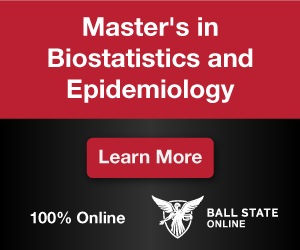 Erik Bloomquist is a senior principal scientist at Merck & Company who works on bringing new oncology and hematological medicine to patients. He is also chair-elect of the ASA Biopharmaceutical Section.
Erik Bloomquist is a senior principal scientist at Merck & Company who works on bringing new oncology and hematological medicine to patients. He is also chair-elect of the ASA Biopharmaceutical Section.It’s a great time to be working as biostatisticians and data scientists in the biopharmaceutical field. In the last 10 years, breakthroughs in oncology drug development have led to unprecedented improvements in survival for cancer patients. Gene therapies based on DNA-editing technologies have achieved cures for diseases such as sickle cell anemia. Additionally, treatments developed for diabetes have the promise to combat the epidemic of obesity within the United States. In the field of diagnostics and technology, simple blood draws may soon be able to detect cancer earlier via floating DNA in the blood, artificial intelligence holds the promise to personalized treatment for patients, and digital health technologies will soon speed up clinical development and decentralize clinical trials.
Underlying all these medical and therapeutic advances are thousands of talented and dedicated statisticians, biostatisticians, and data scientists who design studies, formulate protocols, manage data, implement statistical methodology, validate computer software, review marketing applications, and develop new statistical methods. Much of this work occurs behind the scenes and without public fanfare but, without their dedication, advances would not occur.
Accordingly, demand for statisticians and data scientists in the biopharmaceutical field is expected to grow substantially over the next decade. In 2022, the Bureau of Labor Statistics released numbers that project a 35% growth demand for data scientists and 30% increase for statisticians over the next 10 years. Even today, there are hundreds of thousands of openings for data scientists and statisticians. While writing this article, I did my own search for “statistician” and “data scientist” on a major job site and found nearly 6,000 openings. While the demand projections from BLS and my own search do not focus on just the biopharmaceutical realm, these numbers do point toward a flourishing market for aspiring data professionals.
There is growing awareness among students and university administrations about this trend, leading to an increased interest in pursuing degrees in these fields. In December 2023, the Amstat News article “Data Analytics, Data Science Degrees See Large Increases in 2022” focused on remarkable growth in the number of graduate degrees granted in statistics and biostatistics over the past 10 years. Moreover, it showed a large increase in the number of data science programs and degrees. For example, in 2022 there were 185 universities granting degrees in data science; in 2010, there were only six.
For students, graduating with a degree in statistics or data science is a great first step to gaining employment in the biopharmaceutical field. Yet students also must consider how to network and make connections to secure their desired position. Historically, summer internships have been the tried-and-true method for practical experience and a gateway to employment. By spending 8–10 weeks during the summer working alongside experienced statisticians in an industrial or government setting, students can acquire experience and maturity, often while contributing to a scientific publication—all valuable additions to their résumés.
However, with the rising numbers of students, degree programs, and demand, is a degree and internship still enough to make you stand out? Students can also participate in student paper and poster competitions held by statistical and data science conferences each year. They offer a financial prize or travel support but, more importantly, they offer unparalleled exposure to professional statisticians.
For example, the ASA Biopharmaceutical Section student paper competition for the 2024 Joint Statistical Meetings received a record 42 entries and was able to offer a $2,000 top prize, eight total prizes, a chance to speak during a JSM session, and exposure through its newsletter. Not bad for submitting a paper many students are already writing as part of their graduate work.
Another example is the poster competition for the 2023 ASA Biopharmaceutical Section Regulatory-Industry Statistics Workshop held in September. This annual workshop brings together statisticians from the US Food and Drug Administration and industry to discuss practical and methodological issues in health. It is the Biopharmaceutical Section’s signature event, with attendance growing every year. The 2023 workshop had 1,170 attendees, making it one of the largest statistical gatherings in North America. Learn about the 2024 student competition.
Liwen Wu, a recent PhD graduate from the University of Pittsburgh working at Takeda, and Peng (Jason) Yang, who is wrapping up his PhD at Rice University, submitted winning entries. Their posters were related to the work in my area of oncology. Impressed, I extended invitations for them to join two accepted 2024 JSM sessions I am involved in. Had they not entered the competition, this opportunity would not have occurred.
So, to come full circle, do student paper competitions matter? Yes, but often not for the reasons we initially expect. It’s not about being the top student or receiving a nice financial reward. Instead, it’s about the chance to introduce yourself to professional applied statisticians, demonstrate your involvement in the community, and show off a little bit of your work. These have real payoff in the long term.
For more information about ASA conferences, visit the ASA meetings webpage.




Leave a Reply